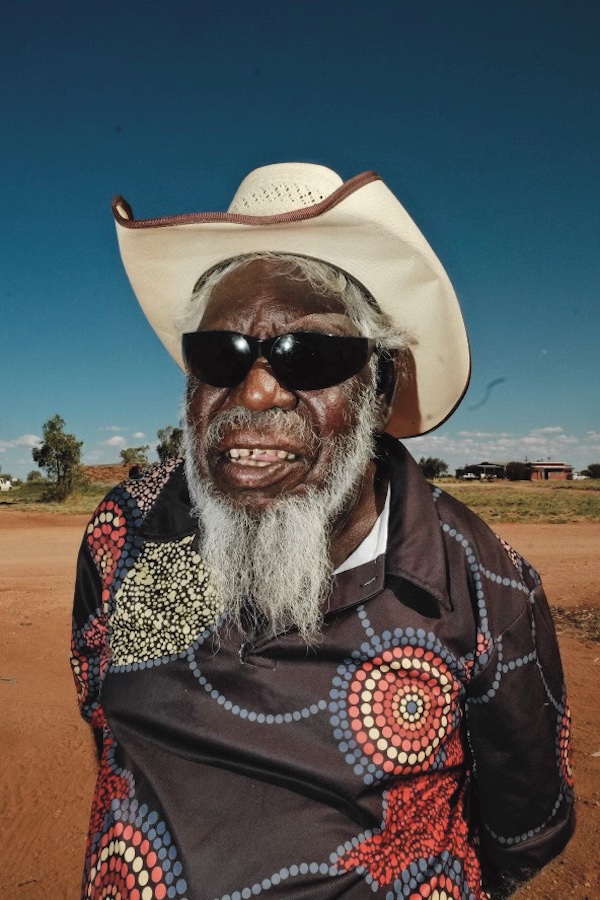Australian contemporary art suffered a sad loss in April, with the passing of Pintupi elder Kumanjayi Tjapaltjarri (Joseph Jurra Tjapaltjarri), one of the second generation artists to emerge from the movement widely considered to have first brought contemporary Aboriginal art to the world’s attention. Known throughout his career as an innovator in the contemporary expression of traditional knowledge, Tjapaltjarri’s unique vision contributed to the development of Western Desert Art at a key moment of its evolution, as Central Australia’s painting communities were determining the levels of access to traditional knowledge appropriate for non-initiated audiences.
Tjapaltjarri was born in Western Australia’s Gibson Desert in around 1952, at Kiwirrkura, around 100 kilometers west of the Northern Territory border. The family moved to Papunya in 1964 and following his father’s death, he was raised by Willy Tjungurrayi and Yumpululu Tjungurrayi (who would both go on to become acclaimed artists), attending the Papunya and Yuendumu schools and working for the Yuendumu Council before establishing his art practice.
Tjapaltjarri learnt to paint in the early 1980s, while assisting Elder Charlie Tarawa (Tjaruru) Tjungurrayi, one of Papunya Tula’s leading first generation artists.
Beginning his own art career in 1986, he held his first solo exhibition with Gallery Gabrielle Pizzi in Melbourne in 1988 and soon attracted international attention, featuring in the landmark Papunya Tula group show at John Weber Gallery in New York in 1989. He remained at the forefront of Papunya Tula’s growing international repute, travelling to Paris in 1997 with Turkey Tolson Tjupurrula to create a sand painting for the Peintres Aborigines d’Australie exhibition, and to the Herbert F Johnson Museum of Art in New York in 2009, with Ray James Tjangala and Bobby West Tjupurrula. Today, his work is represented in major collections including the Auckland City Gallery, the Institute of Contemporary Art Chicago, the National Gallery of Australia, Canberra, and many more. He also served as Chairman of Papunya Tula Artists in 1999 and 2000.
Tjapaltjarri’s works portray events from the Tingari Cycle, a deeply sacred ceremonial men’s narrative which relays the travels of a group of male ancestral beings through desert Country, creating landforms and establishing Pintupi law on their journey. Much of the Tingari Cycle is highly secretive, with Tjapaltjarri’s choice of imagery carefully supervised by senior men during his early career. However, “…these paintings are not cultural relics”, states Utopia Art Sydney director Christopher Hodges. “They are the expressions of a man very much attuned to the world he lives in.”
This frequently included designs associated with the important rockhole sites of Yunala and Ngaminya. Yunala is also the name for an edible tuber or yam. Tjapaltjarri’s sinuous line work represents the plant’s meandering root system and the underground travels of the Tingari.
Hodges first encountered Tjapaltjarri’s work in his landmark Gabrielle Pizzi solo show in 1988, recalling how well received the exhibition was by an audience only just awakening to the significance of Indigenous art. “I was struck by the subtlety of his painting technique and the way he used quite traditional iconography but still retained a very contemporary edge. To the casual observer, these have more in common with Keith Haring’s pop techniques than anything traditional, yet [he] has never studied contemporary art history, these visual inventions are all his own.”
According to Papunya Tula, Tjapaltjarri was very excited for his forthcoming exhibition with Utopia Art Sydney. Though it is heartbreaking that Kumanjayi Tjapaltjarri will not see his final show, the exhibition will provide an opportunity to revel in the final masterworks of a modern icon of Australian painting.
Featured Image: Artist Kumanjayi Tjapaltjarri. Courtesy the artist and Utopia Art Sydney.

